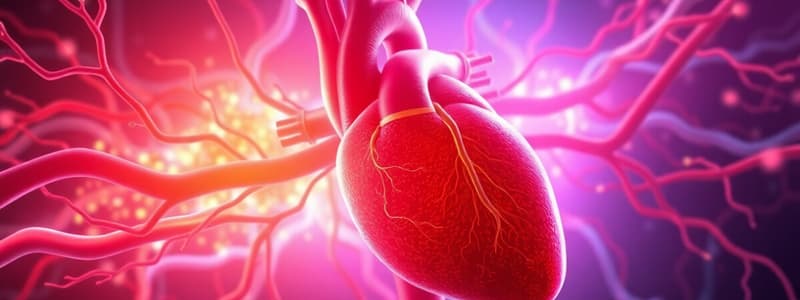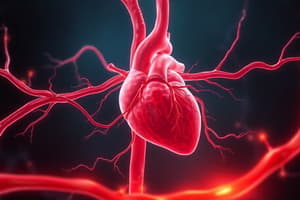Podcast
Questions and Answers
What is a primary function of arterioles in the circulatory system?
What is a primary function of arterioles in the circulatory system?
- Facilitating the exchange of nutrients and waste
- Storing blood for emergencies
- Regulating blood flow and pressure (correct)
- Transporting oxygen from the lungs
Which process describes the accumulation of LDL fats leading to the formation of fatty streaks in the arteries?
Which process describes the accumulation of LDL fats leading to the formation of fatty streaks in the arteries?
- Hypotension
- Hyperlipidemia
- Atherosclerosis (correct)
- Angiogenesis
How does a negative feedback loop function in relation to hypertension?
How does a negative feedback loop function in relation to hypertension?
- By increasing heart rate continuously
- By restoring normal blood pressure levels (correct)
- By preventing blood vessel dilation
- By causing plaque buildup in arteries
Which of the following dietary habits is most likely to increase the risk of atherosclerosis?
Which of the following dietary habits is most likely to increase the risk of atherosclerosis?
What is the end result of the accumulation of fatty streaks and the formation of fibrous scar tissue in atherosclerosis?
What is the end result of the accumulation of fatty streaks and the formation of fibrous scar tissue in atherosclerosis?
Which factor is NOT associated with increasing the risk of cardiovascular disease?
Which factor is NOT associated with increasing the risk of cardiovascular disease?
What occurs when plaque ruptures in an artery?
What occurs when plaque ruptures in an artery?
Which type of fat is known for having a protective effect on cardiovascular health?
Which type of fat is known for having a protective effect on cardiovascular health?
What type of capillary is characterized by having leaky junctions that facilitate material transfer?
What type of capillary is characterized by having leaky junctions that facilitate material transfer?
Which process allows for the mass movement of fluid due to pressure differences within capillaries?
Which process allows for the mass movement of fluid due to pressure differences within capillaries?
What is the primary effect of macrophages engulfing LDL in the development of atherosclerosis?
What is the primary effect of macrophages engulfing LDL in the development of atherosclerosis?
In the context of hypertension, what role does negative feedback play?
In the context of hypertension, what role does negative feedback play?
Which type of capillary has large pores suitable for bulk flow of materials?
Which type of capillary has large pores suitable for bulk flow of materials?
What is the net pressure difference promoting absorption at the venous end of the capillary?
What is the net pressure difference promoting absorption at the venous end of the capillary?
How does diet impact cardiovascular health according to recent studies?
How does diet impact cardiovascular health according to recent studies?
What is the osmotic pressure constant mentioned in relation to the capillary structure?
What is the osmotic pressure constant mentioned in relation to the capillary structure?
What causes the formation of foam cells in atherosclerosis?
What causes the formation of foam cells in atherosclerosis?
Why is net filtration desirable at the arterial side of a capillary?
Why is net filtration desirable at the arterial side of a capillary?
What triggers myogenic autoregulation in arterioles?
What triggers myogenic autoregulation in arterioles?
Which paracrine substance is responsible for vasodilation?
Which paracrine substance is responsible for vasodilation?
What is the role of norepinephrine in sympathetic response during the 'fight or flight' reaction?
What is the role of norepinephrine in sympathetic response during the 'fight or flight' reaction?
In the baroreceptor reflex, increased sympathetic activity leads to what effect on blood pressure?
In the baroreceptor reflex, increased sympathetic activity leads to what effect on blood pressure?
What effect do paracrines have on local blood flow regulation?
What effect do paracrines have on local blood flow regulation?
What structure primarily detects changes in blood pressure as part of the baroreceptor reflex?
What structure primarily detects changes in blood pressure as part of the baroreceptor reflex?
What is the primary effect of increased levels of calcium ions ($Ca^{2+}$) in arterioles?
What is the primary effect of increased levels of calcium ions ($Ca^{2+}$) in arterioles?
In the context of cardiovascular health, which dietary component can contribute to atherosclerosis progression?
In the context of cardiovascular health, which dietary component can contribute to atherosclerosis progression?
What is the relationship between cardiac output and systemic vascular resistance?
What is the relationship between cardiac output and systemic vascular resistance?
How does parasympathetic activity influence heart rate and blood pressure?
How does parasympathetic activity influence heart rate and blood pressure?
Flashcards are hidden until you start studying
Study Notes
The Cardiovascular System
- The cardiovascular system involves a negative feedback loop that involves chemoreceptors, the SA node, ventricles, veins, and arterioles.
- The cardiovascular system is regulated by a homeostatic mechanism which aims to keep blood pressure at a normal level, which is 120/80.
- Hypertension and atherosclerosis are cardiovascular diseases.
Atherosclerosis
- Atherosclerosis is the hardening of arteries.
- Atherosclerosis can be caused by a diet high in fat and cholesterol.
- Plaque can build up in the arteries, which can lead to a heart attack.
Atherosclerosis: Plaque Formation
- Atherosclerosis occurs when there is an excess of low-density lipoproteins (LDL) consumed by macrophages in the blood vessels.
- LDLs attach to the endothelium, forming fatty streaks.
- Excess LDLs can create foam cells which ultimately die and leave behind plaque.
- LDL can also accumulate “under” the endothelial layer, causing plaque to grow on the walls of the blood vessels.
- The plaque can rupture, leading to blood clots.
Myogenic Autoregulation
- Myogenic autoregulation is a local control mechanism for blood vessels.
- The process involves controlling the radius of the arterioles.
- Increased blood flow causes the smooth muscle in the arteriole to stretch.
- Stretch in smooth muscle increases calcium levels, which activates myosin light-chain kinase.
- Myosin light-chain kinase causes the arteriole to constrict.
Paracrine/Hormonal Control
- Paracrine control is a local mechanism for controlling blood vessels.
- Changes in oxygen and carbon dioxide levels change the synthesis of nitric oxide, which leads to vasodilation.
- Other paracrine hormones are released by cells and glands.
Sympathetic Global Regulation: Tonic Control
- The sympathetic nervous system can globally regulate blood vessels through tonic control.
- The hormone norepinephrine, which triggers the fight-or-flight response, can lead to vasoconstriction, diverting blood to the muscles and organs most needed for a response.
- If the frequency of action potentials decreases, then the amount of norepinephrine released also decreases.
The Baroreceptor Reflex
- The baroreceptor reflex is a feedback loop that helps regulate blood pressure.
- When blood pressure increases, baroreceptors in the carotid arteries and aortic arch send signals to the cardiovascular control center in the medulla oblongata.
- The cardiovascular control center regulates the heart rate and stroke volume by the sympathetic and parasympathetic nervous systems.
- The sympathetic nervous system increases heart rate whereas the parasympathetic nervous system decreases heart rate.
Capillary Structure and Function
- Capillaries are the smallest blood vessels.
- They are the site of exchange of materials, including oxygen, carbon dioxide, nutrients, and waste products, between the blood and the surrounding tissues.
- Capillary function is primarily determined by pressure differences between the blood and the surrounding tissues.
- The type of capillary determines how materials move in and out.
Types of Capillaries
- Continuous capillaries are the most common type of capillary.
- Continuous capillaries allow for paracellular transfer, which is the movement of small molecules like oxygen, through leaky junctions between cells.
- They also allow for transcytosis, which is the movement of large molecules like amino acids through the cell.
- Fenestrated capillaries are found in tissues where there needs to be a rapid exchange of materials, such as the intestines and kidneys.
- These capillaries have pores that allow the bulk flow of water and solutes.
Capillary Filtration and Absorption
- The movement of fluid between the blood and the tissues is determined by the difference in hydrostatic pressure and osmotic pressure.
- Hydrostatic pressure is the pressure generated by the blood against the walls of the capillaries.
- Osmotic pressure is the pressure exerted by the solutes in the blood.
- Osmotic pressure is a constant at 25 mm Hg. The hydrostatic pressure at the arterial end of the capillary is 32 mm Hg, so there is a net filtration of 7 mm Hg.
- At the venous end of the capillary (where hydrostatic pressure is 15 mm Hg), this results in a net absorption of 10 mm Hg.
Blood
- Blood components: plasma, red blood cells (RBCs), and white blood cells (WBCs).
- Plasma makes up 55% of blood.
- Plasma is mostly made up of water (92% of mass) and ions.
Studying That Suits You
Use AI to generate personalized quizzes and flashcards to suit your learning preferences.




